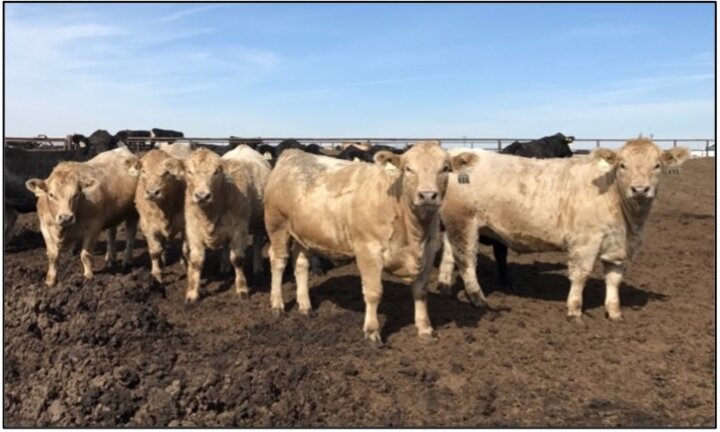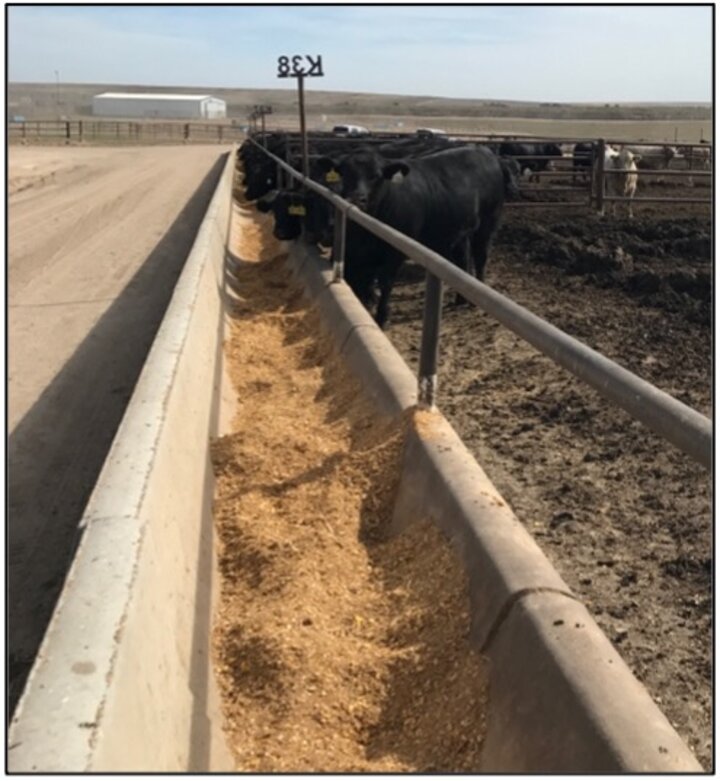Dietary Strategies to Reduce Nitrogen and Phosphorus Excretion in Feedlot Cattle
Nitrogen and Phosphorus Requirements of Feedlot Cattle
Nitrogen and phosphorus are important nutrients in livestock diets, and the minimum requirement of each should be met to maintain animal health and performance. Nitrogen is an essential component of the diet and is provided to the animal in the form of protein. Protein is made up of building blocks called amino acids, and nitrogen is a part of the structure of amino acids. Phosphorus is a key component of bone health and cellular function.

The nitrogen requirements for beef cattle are based on crude protein. Common protein inclusion in finishing diets ranges from 12-14% of diet dry matter with cattle retaining approximately 13% of the nitrogen they consume, excreting the remaining 87%. Based on seasonality, the excreted dietary nitrogen accumulates in the manure or is lost to the environment. On a large feeding operation, this dietary nitrogen excretion in manure can be utilized as a fertilizer, but if not managed correctly, can create environmental challenges.
The phosphorus requirements of cattle vary based on age. Research suggests yearling finisher diets have a phosphorus requirement as low as 0.14% of diet dry matter and calves have a phosphorus requirement as low as 0.16% (Erickson et al., 1999). A typical corn-based finishing diet contains around 0.30% phosphorus, and this percentage increases with inclusion of corn by-products (distillers’ grains) in the diet. Therefore, the contribution of phosphorus from corn grain in the diet is adequate for feeder cattle requirements, and phosphorus supplementation to finishing diets is not necessary.
Environmental Concerns Associated with Nutrient Excretion
Nitrogen, in the form of ammonia gas, can be lost from manure by volatilizing into the air and producing offensive odors. Ammonia is also toxic to aquatic life when present in lakes and streams. Additionally, nitrogen in the form of nitrate has potential to leach through soil and pollute groundwater, negatively impacting water utilized for human consumption and a public health and safety concern.
When excreted in manure, phosphorus is retained in the manure. When land applied, it can bind to soil particles and increase soil phosphorus levels if over applied. Higher soil phosphorus levels move additional phosphorus to surface water with erosion and runoff, causing excessive growth of algae in lakes and streams. Algae blooms can cause fishkills, inhibit the growth of other aquatic species, and release toxins into the water.
What can cattle feeders do to reduce nutrient excretion in manure?
- Managing protein supplementation
- Phase-feeding
- Bunk management
Managing Protein Supplementation
Over feeding of N and P?
Nutrients fed beyond the animal’s requirements end up in the manure. Feeding as close to animal requirements as practical reduces manure nutrients that must be managed.Producers can aim to more accurately meet the nutrient requirements of the animal. While it is important that cattle are supplied sufficient amounts of nitrogen and phosphorus, they are only able to utilize a certain amount offered in their feed, and any nutrients supplied above utilization level are excreted in the feces. As mentioned above, the phosphorus requirement is usually met (and exceeded) by grains and by-products included in cattle finishing diets, and therefore, should not be supplemented.
Testing feed for nutrient content and comparing to nutrient requirements of cattle is an effective method for reducing nutrient excretion from the animal. Selecting the correct protein content of the ration will help to minimize the overfeeding of crude protein and will reduce the amount of nitrogen excreted in manure. Increasing the digestibility of cattle feedstuffs, such as grinding forages or processing grains, can also limit nutrient excretion.
Formulation to meet and not exceed nutrient requirements are important strategies to help feedlot operations minimize excess feeding of nitrogen and phosphorus and become more environmentally sustainable. Checking ration formulations against the nitrogen (protein) and phosphorus requirements that are listed in the Nutrient Requirements of Beef Cattle published by the National Research Council can help to reduce nutrient losses from animals into the environment.
Phase-feeding
What is phase-feeding?
Dividing the growth interval into several phases and offering diets that more closely meet the nutrient requirements of the cattle in a particular phase.Nutrient requirements change as animals progress from one phase of production to another. For example, the nutrient requirements of calves are vastly different from nutrient requirements of yearlings. Phased (or group) feeding is where different concentrations of nutrients are fed to animals with similar expected average daily gain. By dividing the growth interval into several phases, with a smaller spread in body weight, the diets fed more closely meet the nutrient requirements of each animal in the group (i.e., nutrients are not being overfed). As a strategy to reduce nutrient excretion, cattle feeders typically feed a constant level of crude protein and other nutrients from day 24 of feeding to harvest. Accurate phase feeding that more closely matches an animal’s requirements will result in fewer nutrients excreted into manure.
Bunk Management

Bunk management is precisely matching feed deliveries to the amount of feed cattle need for optimal performance. Minimizing feed waste (feed delivered to the animals but not consumed) is achieved by regularly adjusting the amount of feed delivered, using proper feeder design, and regular maintenance of bunks. Sufficient bunk management helps cattle feeders deliver the same quantity and quality of feed to the cattle each day, aiming to minimize variation. It is suggested that cattle are fed within 15 minutes of the same time each day to maximize feed intake performance. Reducing variation within the bunk reduces variation in cattle feed intake, resulting in reduced feed waste. Decreasing wastage ultimately reduces the amount of nutrient loss from unused feedstuffs into the environment.
Conclusion
Managing protein levels of the diet, phase-feeding, and bunk management are all strategies to manage nutrient intake and work to minimize excessive nitrogen and phosphorus excretion in feedlot cattle.
To learn more visit Feeding Strategies to Lower Nitrogen and Phosphorus Levels in Manure
Literature Cited
Erickson, G.E., T.J. Klopfenstein, C.T. Milton, D. Hanson, and C. Calkins. 1999. Effects of dietary phosphorus on finishing steer performance, bone status, and carcass maturity. J. Anim. Sci. 77:2832-2836. https://doi.org/10.2527/1999.77102832x
Klopfenstein, T. J. and G. E. Erickson. 2002. Effects of manipulating protein and phosphorus nutrition of feedlot cattle on nutrient management and the environment. J. Anim. Sci. 80:106-114. https://doi.org/10.2527/animalsci2002.80E-Suppl_2E106x
Spiehs, M. J. 2005. Nutritional and feeding strategies to minimize nutrient losses in livestock manure. University of Minnesota Extension Service. Retrieved October 18, 2020 from https://www.thepigsite.com/articles/nutritional-and-feeding-strategies-to-minimize-nutrient-losses-in-livestock-manure
Sutton, A. 2016. Feeding strategies to lower nitrogen and phosphorus levels in manure. Michigan State University Extension. Retrieved October 18, 2020 from https://www.canr.msu.edu/resources/feeding_strategies_to_lower_nitrogen_and_phosphorus_levels_in_manure_e2822
Vasconcelos, J. T., L. O. Tedeschi, D. G. Fox, M. L. Galyean and L. W. Greene. 2007. Review: Feeding nitrogen and phosphorus in beef cattle feedlot production to mitigate environmental impacts. Prof. Anim. Sci. 23: 8-17. https://doi.org/10.1532/S1080-7446(15)30942-6
This article was reviewed by Andrea Watson, Research Assistant Professor; Aaron Berger, Nebraska Extension Educator; Hannah Speer, UNL student